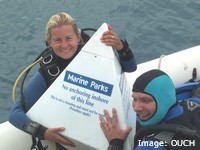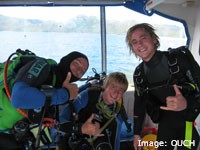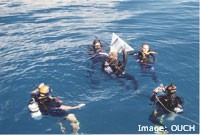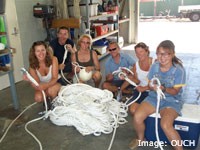



Reef Protection Marker Buoy Program
It is no secret that anchors, chain and coral reefs do not mix well. The reefs always lose. The purpose of the Reef Protection Marker Buoy Program is to reduce anchor damage to corals in a cost effective manner.
This project started in 1994, in response to increasing anchor damage to the fringing reefs of the Whitsunday Islands. It should be noted that the Whitsunday region of the Great Barrier Reef Marine Park and World Heritage Area is second only to Cairns as a tourist destination and sees nearly 600,000 visitors every year. The major attractions in the area are the islands and associated fringing coral reefs. Currently, there are over 300 boats operating in the Whitsundays.
OUCH, in conjunction with Queensland Parks and Wildlife Service (QPWS), created this program, which now protects 10 bays with nearly 50 specially designed reef protection marker buoys and 86 moorings. As new funds become available, more fringing reefs are slated for surveys, marker buoys and moorings.
It should be noted that the Reef Protection Program has spread beyond the shores of the Whitsundays. Marker buoy/mooring systems are now being used up and down the Great Barrier Reef coast, as far west as Perth and as far north as Hong Kong.
The Reef Protection Marker Buoy Program has been one of OUCH's most successful and important endeavours. The project is as simple as it is effective, involving 4 distinct steps.
1. Selection of the site. The term "sensitive site" is used here to denote locations of medium to high conservation value, which are currently under significant anchoring pressure (commercial and recreational) or have exhibited marked deterioration in reef condition. Reef managers, commercial operators and the public all have input into the site selection process.
2. Reef survey. The entire sensitive site must be surveyed (above and below water) to determine the extent of damage and to map the edge of the reef for future marking.
3. Installation of marker buoys. Moorings for the pyramid-shaped buoys are installed in the seafloor with a drilled/ cemented pin. The buoys delineate the edge of the reef and anchoring is not permitted on the landward side of the buoys.
4. Maintenance. Due to the wear and tear of the ocean and occasional public misuse, this part of the project is forever ongoing. The buoys are inspected and cleaned quarterly. The tackle and buoys are replaced annually, and recycled whenever possible.
To date, OUCH has surveyed and marked 10 fringing reefs in the Whitsunday region. The project has successfully reduced anchor damage to reefs by an estimated 80%. The marker buoys are now being used throughout the Great Barrier Reef Marine Park.
Moorings, which eliminate the need to drop an anchor, are still recognised as the best tool to prevent anchor damage in the marine environment. However, moorings are expensive to install and maintain, and also carry a liability responsibility. The marker buoys are a cost-effective alternative that can be used in conjunction with a mooring system.


